Dec 13 2022
Genetically Engineering Sex Selection
 I wrote one year ago about a potential technique to create offspring in animals used for research or food of just one sex. For example, the chicken industry culls several billion male chicks each year because they have no commercial value. They don’t lay eggs and they are not optimal for growing for meat. Now Israeli researchers announce they have developed a second entirely different method of sex selection in chicks.
I wrote one year ago about a potential technique to create offspring in animals used for research or food of just one sex. For example, the chicken industry culls several billion male chicks each year because they have no commercial value. They don’t lay eggs and they are not optimal for growing for meat. Now Israeli researchers announce they have developed a second entirely different method of sex selection in chicks.
Sex selection in animals can be extremely useful, to avoid unnecessary culling and also to increase efficiency. Often research requires either all male or all female animals of a specific genetic strain, and so those in the litter of the unwanted sex are simply culled. Of course the chicken industry dwarfs this practice with billions culled each year. The technique described a year ago involves inserting a CRISPR kill-switch into the DNA of the parent animals. Half of the kill switch is implanted in the male and half in the female. If the two halves come together in the offspring, then the embryo never develops beyond the 16-32 cell stage. For a chicken, the egg will never hatch.
For mammals, like mice and rats, females have XX chromosomes while males have XY. The female half of the kill switch is inserted into both X chromosomes of the mother, while the other half is inserted in the X chromosome of the father if you want all male offspring, or the Y chromosome if you want all female offspring. Birds are the opposite – the females have WZ chromosomes, while males have ZZ, but the principle is the same.
The Israeli team has developed a different method. They only have to genetically engineer the female parent, inserting a gene for a protein on either the W or Z chromosome for chickens. For female-only offspring they insert it on the Z chromosome of the mother, so that only the ZZ males will carry it. The resulting eggs are then exposed to a blue light for several hours, which activates the protein and prevents further development. Therefore, only the female eggs hatch. Also, the resulting females are not genetically altered in any way, since the gene was only inserted into the male chromosome. The researchers still need to publish their results so that they can be independently verified. The technique should work, but there are details we would want to see, such as the success rate. Even if a small percentage of males survive, that could still be a huge problem for the production process.
Assuming these techniques work, which they probably will, the final question is regulatory acceptance. The UK is already signaling that they will allow this type of genetic engineering. Also, the animal welfare group, Compassion in World Farming (CIWF), supports this research and its application. There will likely be the usual push back from groups like PETA and hard core anti-GMO groups, but it does seem like the switch from genetic modification to genetic engineering has taken some of the wind out of the sails of GMO opposition.
Some of the change is purely in terminology. To add to confusion, various countries do not define the terms the exact same way. In the US, the term “genetic engineering” is now defined as any technology that changes the genetics of an organism by “introducing, eliminating or rearranging specific genes using the methods of modern molecular biology.” Meanwhile “genetically modified” refers to any method of modifying genes, including traditional breeding methods or non-GE technologies like mutation farming. By this definition, almost any food we might it is technically a GMO. Part of the change is the result of newer technology that allows for the silencing or amplification of genes already present in an organisms, and therefore is genetic engineering without introducing a new gene. I don’t think this really matters, but it is the insertion of unrelated genes that has been the focus of most of the anti-GMO fearmongering.
The Israeli technique is a good example of how newer genetic engineering technology has significantly muddied the waters. While the resulting chicks will be the product of genetic engineering, they themselves are not genetically modified in any way. The terminology change also emphasizes the fact that “GMO” was always an artificial category that did not make scientific sense. It unfairly singled out specific technologies, while turning a blind eye to farming techniques like mutation farming (literally exposing seeds to radiation or mutating chemicals) in order to create new cultivars. The reason for this is that our agricultural industry is rife with cultivars created through mutation farming and it would simply not be practical to remove them from the industry. And forget about hybrid technology, which (prior to newer GE techniques) was responsible for over 90% of agricultural plants grown.
Sex selection is also a good example of how beneficial genetic technology can be. In this case it has the potential to eliminate the culling of billions of animals. It’s difficult to oppose such a technology on ethical grounds. Of course, such concerns have never stopped the hard core anti-GMO crowd, who oppose the introduction of engineered rice that can save millions of poor children from blindness and death. The terminology and technology changes do make it easier to marginalize the extremists, however. This is necessary, because the benefits of genetic technology are significant and we will need them as the world’s population rockets past 8 billion people.






